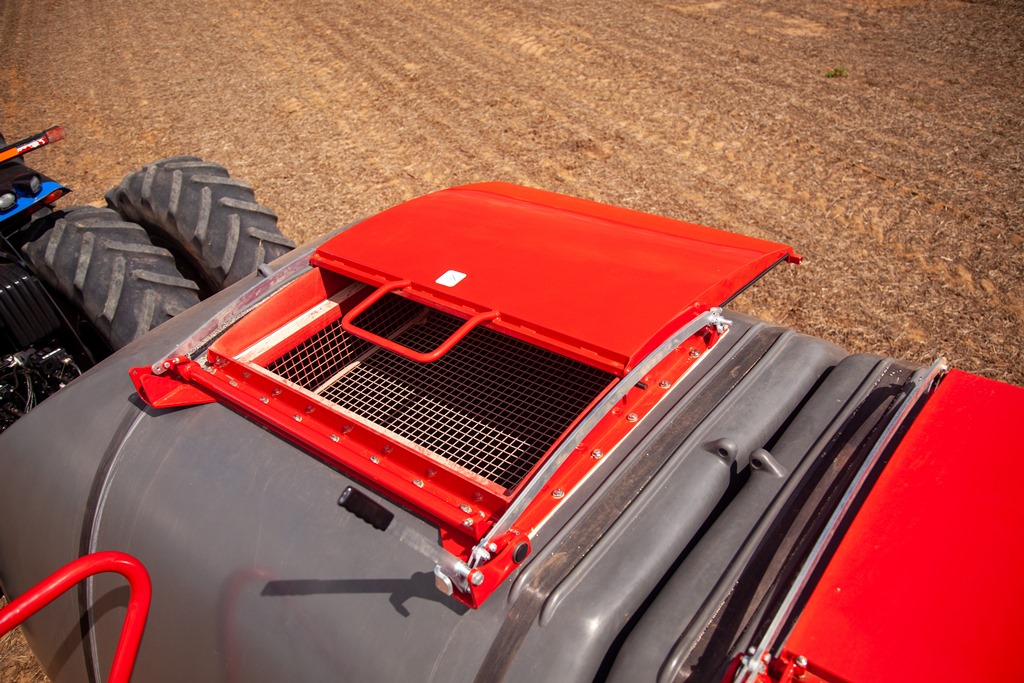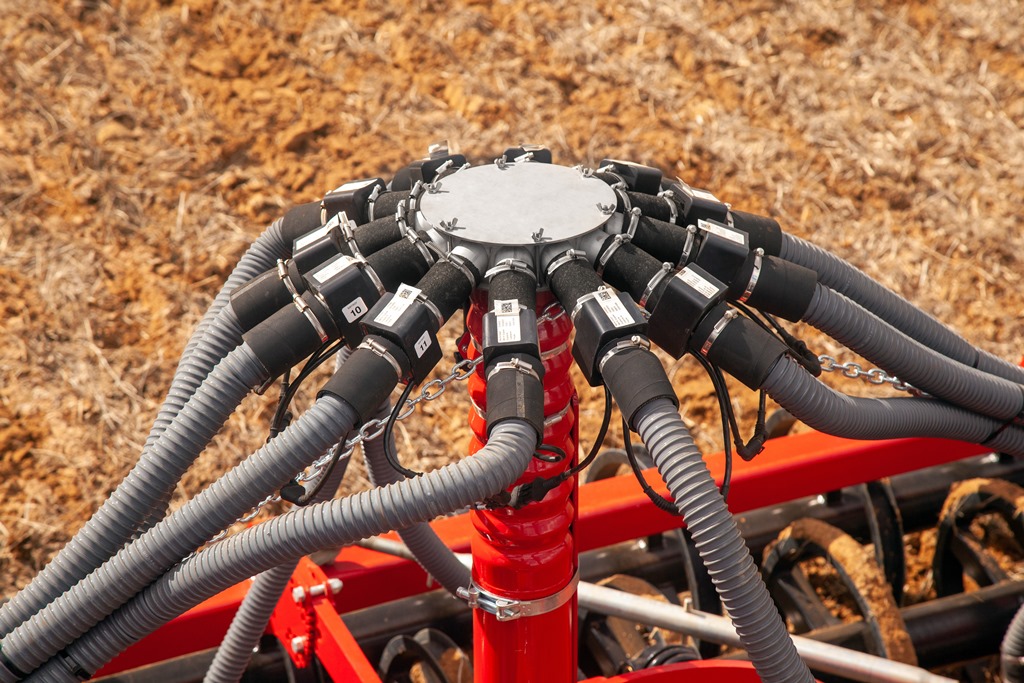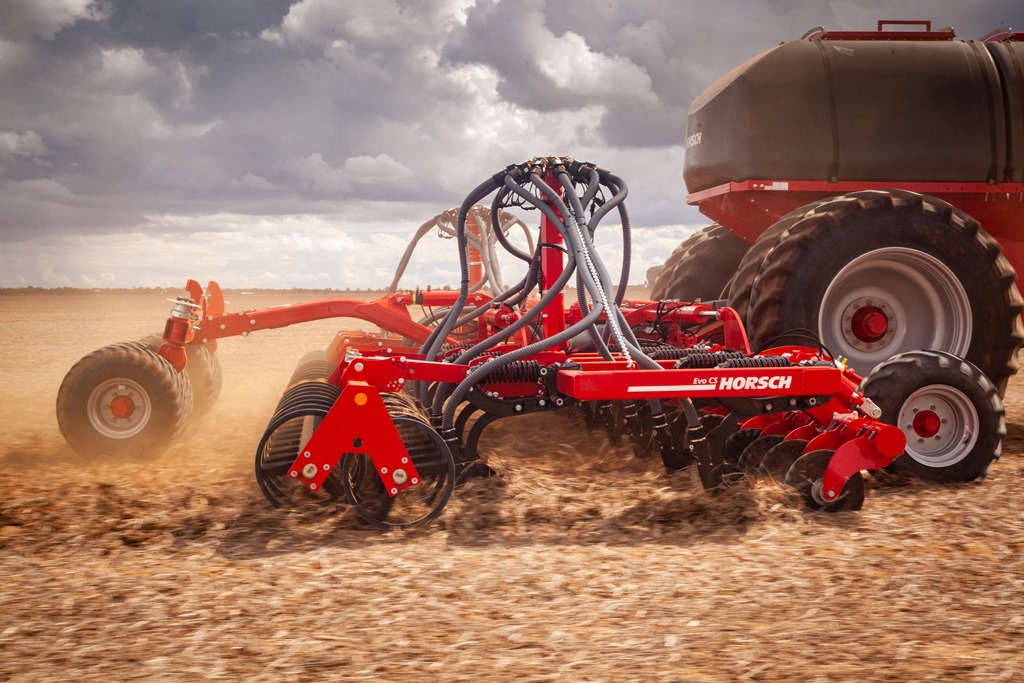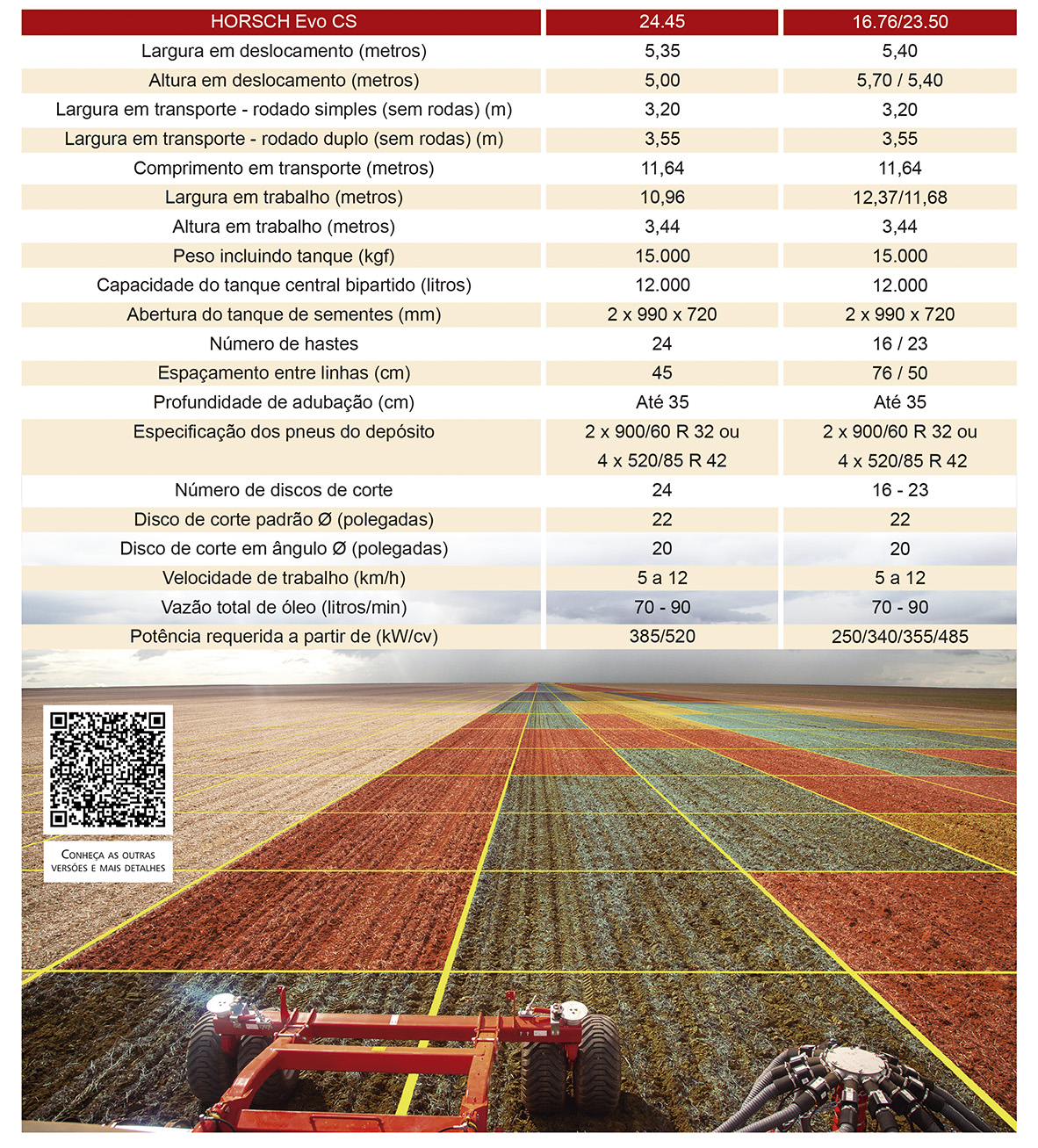Spraying, technology and the environment
By Fabricio Müller, Senior Product Manager and Strategic Marketing for Planting and Spraying at AGCO South America
The Evo CS Fertilizer, from Horsch, is a multitasking equipment, which allows three operations to be carried out in one pass: applying fertilizers, decompacting and sowing cover crops.
The Evo CS fertilizer machine is equipment designed to apply granular fertilizer in depth in the line. The recent practice of fertilization, as a separate operation from sowing, has become quite common in mechanized agriculture. There are several beneficial effects of separating these operations. The two main advantages are related to the positive effect of bringing forward fertilization, in relation to the moment of sowing and also due to the fact that with separate operations, better operational efficiencies are achieved, especially in sowing, which can compensate for the higher cost of developing two operations. With this anticipation of the operation, it is possible to make better use of the planting window, carrying out the operation in a period of lower soil humidity (off-season), suitable for soil decompression work.
One of the great advantages of this type of equipment is the better distribution performance, compared to centrifugal distributors, which in addition to presenting deficiencies in uniform distribution throughout the application range, place the fertilizer only on the surface. It is known that some nutritional fertilization elements decompose under sunlight and others have very low mobility, such as phosphorus. Furthermore, the Evo CS fertilizer machine also decompresses in advance, within the soil profile, at depths greater than those practiced at the time of sowing. Therefore, it is equipment that can be perfectly integrated into a direct planting system, promoting physical and nutritional restoration.

For all these reasons, this equipment is recognized as a multitasking machine, which performs three operations in a single pass, fertilizing, decompacting and, if equipped with an option, it can introduce seeds of soil-recovering plants.
This machine is a project developed at the German headquarters for Brazilian customers and configured for the particular conditions of our agriculture. There are two models offered on the Brazilian market. The first, in configuration 24.45, has fixed sections on the support, 10,8m wide, with 24 rods and 0,45m spacing between rods. The second, 16.76/23.50, has the possibility of varying from 16 rods with a spacing of 76cm and a working width of 12,16m to 23 rods with a spacing of 50cm and a working width of 11,50m.
A split polyethylene tank (one half for each doser) is mounted on a very resistant structural chassis, with a capacity for 12 thousand liters of fertilizer, equipped with an agitator that is activated during maneuvers, whenever the machine is raised or lowered, It does not depend on whether it is in the headland maneuver or in the middle of the field. The machine structure is supported by radial tires, which can be run single, in specification 520/85 R42, or double, specified as 900/60 R32.

Working autonomy is an important characteristic of a large machine, aimed at large explorations and with high technology. This machine has the capacity to distribute products over an area of 60 hectares, with a dose of 200kg/ha, without requiring refueling. It is equipment that presents high operational efficiency, due to its large tank capacity, which means fewer stops, faster refueling and easier maneuvering and transportation.
A fundamental system that guarantees the quality of distribution is the set of fertilizer driving, dosing and delivery mechanisms, made up of a turbine, dosers, conductive tubes, distribution towers and furrowing rods, through which the material reaches the ground, at the point where you want it.
The system starts with a turbine, driven by a hydraulic motor, placed under the front part of the tank. This turbine pressurizes the tank, driving the material to the dosers, and generates an air current, which transports the material to the two distribution towers, through two individual ducts.

For the positive pressure system of the fertilizer tank, it can be up to 150mBar as needed. The higher the desired application rate and speed, the greater the air pressure to be able to move the material. These towers behave like a flow divider, receiving the material and directing it to the conduits that connect to the rods.
The turbine rotation can be changed from the tractor's operating station, on the monitor, by controlling the continuous oil flow through the corresponding VCR valve. Therefore, with greater rotation, the greater the positive pressure and, therefore, the greater the amount of product that reaches the fertilizer dosing rotor. A sensor measures the rotation and informs the operator, who uses this parameter to adjust the dose.
The dosers (rotors) are placed at the bottom of the tank and driven by a variable electric motor, dosing the amount of product that must be applied. To calibrate the dose to be applied, you can also combine the type of rotor, whether silver (stainless steel) or yellow, to vary from 100kg/ha to 1.000kg/ha. After choosing the doser, the product dosage is calibrated to check.

The project included the machine with a flow sensor, which allows possible flow failures to be detected. Any failure due to obstruction is quickly detected. The accuracy of the dosing system is high, as it is possible to reach rates of up to 1.000kg/ha, at a speed of 5km/h with a variation of 5% in relation to the desired quantity.
A 400-liter auxiliary tank can be used to distribute small seeds along the line, along with fertilizer. This device, called MiniDrill, inserts fine seeds into the air stream flow to two mini distribution towers and from there to the rows of furrowing rods. It can be distributed on the line or spread with the help of a deflector. With this device it is possible to achieve an application rate of up to 160kg/ha of seeds.
The mechanism for introducing the material into the soil uses furrowing rods, which work a furrow up to 35cm deep, placed alternately, one line in front and one behind, to improve straw flow and reduce traction effort and soil disturbance. The material used to construct the rods was specially developed and selected with a view to durability. There is a system called TerraGrip, placed on each rod that gives them flexibility and prevents them from being subjected to excessive stress. Two springs (one external and one internal) protect the rod, absorbing excessive forces arising from obstacles, serving both to disarm and to re-arm the rod in its working position. Approximately 550kgf of force can be absorbed and the rod can move approximately 30cm from its original position.

The fertilizer enters through the back of the stems. A difference in product positioning is made with a divider that directs the product into three positions: on the surface, half of the product on the surface and half at the working depth or the total product at the depth established by the user.
In front of the furrowing rods, the machine features cutting discs, each 22 inches in diameter, intended for cutting straw. On the support, there is a device for hydraulic adjustment of the angle of attack, which can be done from the tractor cab.
Just behind the line of furrowing rods there is a set of de-clogging rollers for leveling the soil and accommodating the straw. These two rows of rollers should preferably work horizontally level, but with the depth given by the front row of rollers. This adjustment is manual, by choosing the position of screws in holes.
The necessary adjustments for the machine to function properly include leveling the tank structure using a hydraulic piston and adjusting the position of the hitch to the tractor. With the structure leveled, finer adjustments are made, regulating the working depth of the rods, through the support tires, hydraulically. Finally, at the back of the machine there is a structure for controlling and adjusting the working depth, supported by tires, which can be hydraulically activated directly from the operator's station. At this point, it is recommended to place fixing blocks for transport, which is the other function of this component.

This machine has already undergone a lot of development, testing and use on a huge number of hectares, mainly in the states that represent the new Brazilian agricultural frontier. During this use, the most different conditions were experienced and it is clear that for the application of the largest doses, close to 1.000kg/ha, speeds of around 5km/h are recommended and for smaller quantities, limited to 100kg/ha, it can be travel at speeds close to 12km/h.
As for the power demanded, it is proportional to the working depth, type and resistance of the soil and travel speed. As the traction power is proportional to the traction force (which depends on the depth and soil) and the speed, to reach extreme depths, close to 35 cm, approximately 520 hp of engine power is required in dry and hard soil. tractor engine. Evidently, if the depth is smaller, close to 10 cm, 370 hp of engine power will be sufficient for the operating speeds practiced in this operation.
As this machine has large dimensions, it is important that it has width reduction mechanisms for autonomous transport, ensuring that, with the collection of sections, the total width is reduced from 10,8m to 5,35m and the height of the equipment stay at approximately 5m, so that it is perfectly compatible for movement on roads, internal travel routes and even access in storage environments. The system adopted in this project allows the machine to move at speeds considered high for transport, as long as safety conditions are met. For the beginning and end of the operation, when it is necessary to open and close sections, the two sides collapse onto a fixed one in the center.

When disassembled into two parts (wagon and wings), for transportation on flatbed trucks, the maximum width is 3,35m for the version with double wheels and 3,20m with single wheels, and in this second option it is possible to move the truck without the need for beaters.
In terms of technology incorporated into a fertilizer machine, the Evo CS can be considered to have a much higher level. If the user activates the software, they will be able to release the monitor and use this precision agriculture feature, making it possible to control the amount of fertilizer placed in the soil on a specific site, using variable rate and section control features. This device is standard and only requires activation of the monitor. So it is possible to use prescription maps and when activated, you can precisely apply the fertilizer prescription from the map. In the tests carried out and in the use of the equipment, it was recommended that the amplitude of the dose variation in different applications should not be exaggerated, so as not to cause too much difference in displacement speed, necessary so that, in combination with the action of the doser, it is possible to carry out as prescribed.

Section control saves fertilizer and avoids overdosing, because if the machine applies it to a place that had already been applied, it cuts off the flow of product, avoiding overlapping passes.
All machine behavior, such as the application map, routing, section cutting, etc., can be viewed on the Horsch Touch 800 monitor, which is fully compatible with the Isobus standard and, therefore, can be interchanged with the monitors of brands of tractors that are of the same standard.

Discover other versions and more details by clicking here.

Receive the latest agriculture news by email